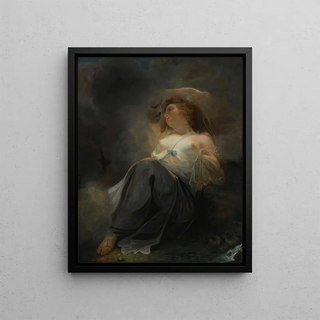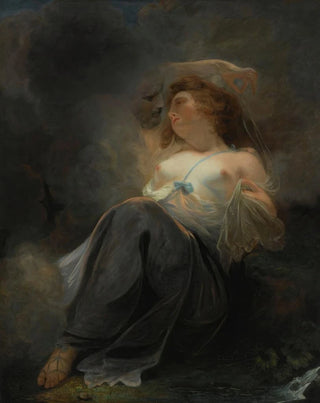Art print | Jupiter and Io - John Hoppner


View from behind

Frame (optional)
John Hoppner's "Jupiter and Io" artwork is part of an artistic tradition where mythology and sensuality intertwine to offer a narrative and aesthetic representation. Immersing oneself in this iconic scene, the viewer is immediately transported to a world where the gods of antiquity come to life, embodying human passions and deep emotions. Hoppner, with his technical skill and keen sense of composition, manages to capture the intensity of a fleeting moment, where love and desire clash with the stakes of divine power. This piece, both delicate and powerful, invites us to explore mythological stories while appreciating the virtuosity of an artist who has left his mark on his era.
Style and uniqueness of the work
Hoppner's style is distinguished by his ability to blend realism with a touch of romanticism. In "Jupiter and Io", the figures are rendered with remarkable finesse, each detail of the human body treated with precision that reveals the artist's mastery. The color palette, rich and nuanced, evokes an atmosphere that is both warm and mysterious. The drapery of the clothing, flowing and elegant, seems almost alive, while the expressions of the characters convey a striking emotional depth. Light plays a crucial role in this composition, subtly illuminating the faces and accentuating the forms, creating a play of shadows and lights that adds dynamism to the scene. This work is much more than a simple illustration of a myth; it is an exploration of human relationships, passions, and conflicts that transcend time.
The artist and his influence
John Hoppner, born in 1758, established himself as one of the most prominent portraitists of his time, but his work goes far beyond simple portraits. Influenced by masters of European painting, notably Titian and Rubens, Hoppner was able to incorporate their teachings while developing a personal style that is uniquely his own. His approach to mythology, as exemplified by "Jupiter and Io", reflects a romantic sensibility that prefigures future artistic movements.

Matte finish

View from behind

Frame (optional)
John Hoppner's "Jupiter and Io" artwork is part of an artistic tradition where mythology and sensuality intertwine to offer a narrative and aesthetic representation. Immersing oneself in this iconic scene, the viewer is immediately transported to a world where the gods of antiquity come to life, embodying human passions and deep emotions. Hoppner, with his technical skill and keen sense of composition, manages to capture the intensity of a fleeting moment, where love and desire clash with the stakes of divine power. This piece, both delicate and powerful, invites us to explore mythological stories while appreciating the virtuosity of an artist who has left his mark on his era.
Style and uniqueness of the work
Hoppner's style is distinguished by his ability to blend realism with a touch of romanticism. In "Jupiter and Io", the figures are rendered with remarkable finesse, each detail of the human body treated with precision that reveals the artist's mastery. The color palette, rich and nuanced, evokes an atmosphere that is both warm and mysterious. The drapery of the clothing, flowing and elegant, seems almost alive, while the expressions of the characters convey a striking emotional depth. Light plays a crucial role in this composition, subtly illuminating the faces and accentuating the forms, creating a play of shadows and lights that adds dynamism to the scene. This work is much more than a simple illustration of a myth; it is an exploration of human relationships, passions, and conflicts that transcend time.
The artist and his influence
John Hoppner, born in 1758, established himself as one of the most prominent portraitists of his time, but his work goes far beyond simple portraits. Influenced by masters of European painting, notably Titian and Rubens, Hoppner was able to incorporate their teachings while developing a personal style that is uniquely his own. His approach to mythology, as exemplified by "Jupiter and Io", reflects a romantic sensibility that prefigures future artistic movements.






